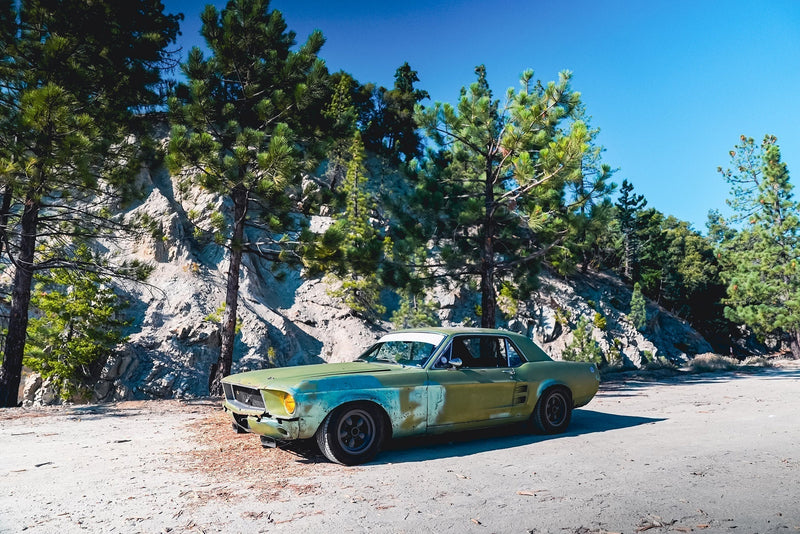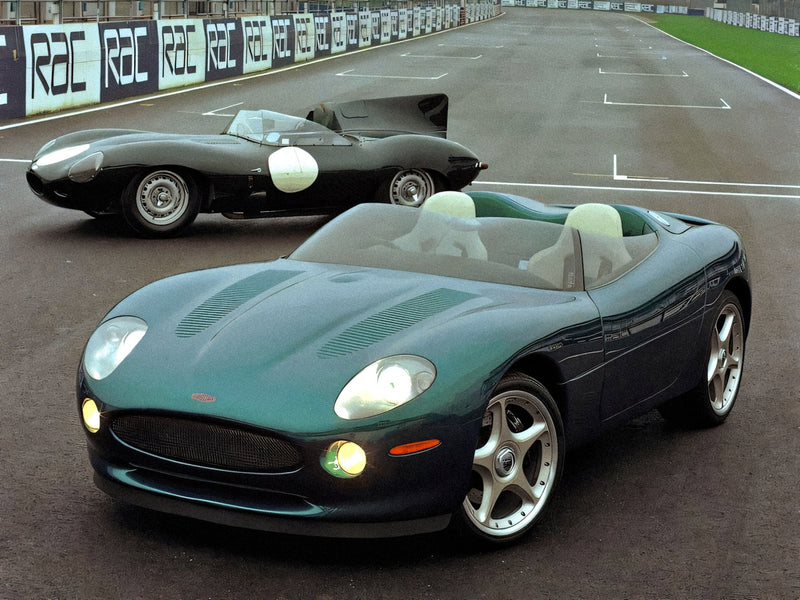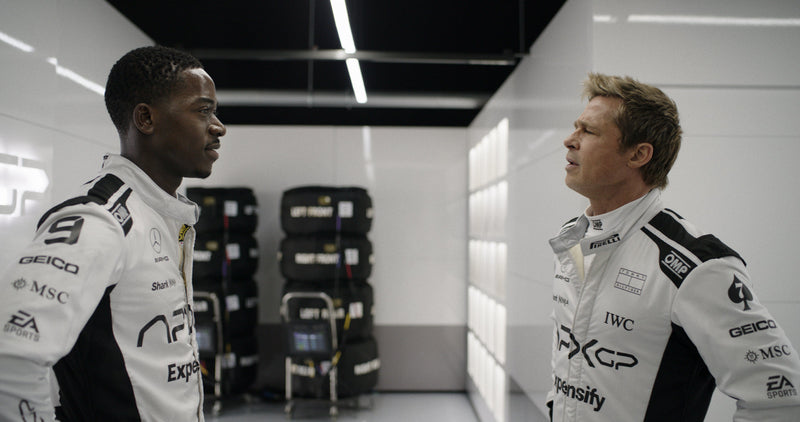For Phil Mulacek, he didn’t have a choice in becoming a gearhead—not that you’ll see him complaining behind the wheel of authentic Shelby Cobras or GT40s—but Phil was surrounded by it. There was simply no avoiding it. He’s played a big part in continuing the family tradition of racing classics, now on its third generation of wheelmen. Here’s his family’s tale of petrol burning glory.



Andrew Golseth: Phil, tell me how it all started.
Phil Mulacek: My father actually liked automobiles and bought his first AC Bristol in 1958 when he was stationed in Paris, that’s where he met my mother. He started racing before I was even born so we grew up at racetracks. Before there was all the insurance complications, when I was 15 I could help take a car to the track, put a suit on, hop in, and get my dad qualified onto the grid. Then he’d come and race Saturday and Sunday after I got him qualified on Thursday and Friday.
We were growing up in it. You know we use to have Peter Revson, Bruce McLaren, and Jackie Stewart hanging out in our trailers? In hindsight you recognize how important that was but at the time it was, like, no big deal. We were around it all the time. When you use to win, they’d let you do a parade lap with the checkered flag, so I’d hop in and wave the flag out the window in the passenger seat.
We used to be corner workers, my brother and I, back when the insurance wasn’t so crazy. For events like the Chicago June Sprints, when the old historic races first started, we volunteered. At the end of each day, these really nice cars that were racing, they’d pick you up on the corner. One time, I got a really nice ride back in a stunning Ferrari 250LM and that hooked me.
That was a really special thing. If you worked your tail off, you know, in the hot weather or rain, to get a ride in those kinds of cars with the driver pushing it maybe 85% so we could get a real sense of the car, that was really something. That was something special. I remember, I couldn’t even see over the full windscreen as a little boy, but I could help drive around the track.
Once I was in high school I started buying cars. I remember sitting on a milk crate in a 250 SWB California Spider we had 17-grand in and now they’re worth 17 million—just absolutely crazy stuff!




AG: Wow, I was born in the wrong era. First, your father, then you and your brother, what about your kids?
PM: My sons are now at the races and I’ve helped nephews learn to race too. We had six drivers at COTA this past week, we’re really a unique family—three generations now. My father was a very good driver, he won national championships in SCCA, but he had a couple of pretty serious accidents and my mother said, “Hey, your super professional racing career is over. You need to race as a hobby.”
So, now we just do vintage racing where contact is not acceptable. But you can still drive original cars, we’re not modified guys or running prototypes. We stay purely the medallion type class. Original Mustangs, original GT40s, original Cobras, sort of that Ferrari/Ford era is where our love and passion is.
AG: It's awesome the family tradition is still going. I’ve got to ask, being around all those machines, what was your first car?
PM: I had a 1954 Ford pickup truck that I souped-up. Then we did a Cobra, a 427, but my dad said I couldn’t take that to college so we sold it. Then I bought three AC Bristols in college and continued to buy and collect cars. My brother did the same thing, from Alfas to Bristols to Ferraris.
But our love was really for Ford muscle cars. The Shelbys, the Mustangs, the Cobras, the GT-40s, and Ferraris were, and still are, pieces of art. But our love is really Fords/Shelbys. When we were first getting into all this, everyone was into cars like the new Cutlass and Camaro SS, and we had all this old vintage stuff that is now priceless - stuff that then people just didn’t care about.
AG: So, that’s sort of where the love for Ford started?
PM: Yeah, that started in high school but we got more and more into it when we got into vintage racing because they were still affordable. The average guy could take a Shelby - it’s not like you were spending 20-million dollars - and go out and race them without being a multi-millionaire.



AG: Tell me about racing this particular Cobra—what’s the history?
PM: This is a 1966 Shelby Cobra. It’s actually the car Carroll Shelby used when he was inducted into the hall of fame. It’s been raced in SCCA, SVRA and other vintage events across the country. This one is a 427 AC Shelby Cobra—it’s solid. We’ve got some good podiums with this car. We won first in the enduro with myself, my brother, and nephew all as drivers.
It was a streetcar originally. The 427, most people can’t handle them. They are fabulous cars. Extremely fast, super light, but you put that on any changing road condition, if it’s wet and you don’t drive it right, you’re off! A guy wrecked it so people picked it up and took the core components of the car, I think the door and some trunk panels went elsewhere they were so trashed, and the chassis was upgraded to a race car. The tubes were strengthened and its since been racing in the Midwest and West Coast for the last 20 years.
When I first started driving the car, I learned it on an open track day where there weren’t a lot of people so I could push it and understand when the torque was going to come on. It takes a lot of feathering. I’ve been racing it for a few years and know the prior owner real well. He actually used to race it with my father’s brother, so it has been around the family for a very long time. We still work together and he helps us with engine freshening. We do the tuning, body, suspension and other work ourselves.
We’re not a shop, we’re just a family so we’re very hands-on. When we started, we did everything but now we’ve got six drivers and so many cars, we need a little help with the prep. We race them but we don’t push them if there’s a light problem. Our vintage racing concerns are: safety first, car second, race is last. That’s our total philosophy. We just want to all be there at the end, enjoy the race, and celebrate.
AG: That’s what it’s all about. I’m sure you don’t need me to remind you, but these cars—like the Cobras and GT40s—have really gone through the roof. Does that make you nervous about racing them?
PM: No. Guys with replicas ask, “How can you race something that expensive out there?” We just take care of it. There are crazy people who drive too risky that we stay away from and we compete in the endurance races. We like the longer races so we can do more driver changes, so everyone can get a lot of seat time.
We’ve got so much family, it’s just about having fun and I think that’s lost some people. (laughs) People get so concerned with the price they forget that enjoying them is what cars are all about.





AG: Well said. You’re running with a lot of incredible machines, what makes driving the Cobra so special?
PM: Knowing you’re in a car that finished Le Mans, you have a totally different respect. On a track? The 250 LM is heaven. You’re in a cloud. But the Cobra? It’s a beast. It’s like a tiger, man. When it’s dug in, it’s there. You know you’re on it. When you know how to drive it, you’re not afraid, but you absolutely respect it.
I have guys coming up that say, “I just love it when you pass me,” because they just love the sound. I love being the cat versus the mouse. It’s so much fun to out-brake them and get them in the right spot. It’s fun! That car has all that lightness, better brakes, and all that power and torque. It’s a real ballerina out there with a big block Cobra. The 289 is a little smoother, but the 427 is so fast.
AG: “It’s like a tiger.” Love it. What is it about vintage racing, the sport, that’s so unique?
PM: It’s art, really. The cars are beautiful and the people you meet have the same passion. There are some professional gentleman standards that are justthere . In vintage racing, we draw the line. We don’t go that extra step to abuse or put someone else or their car at risk. It’s not cut throat but it’s as competitive as you can get without crossing that line.
Every sense is at its the peak when racing. All five senses are used. We can be aggressive and be competitive but we all know the line–we can all have a beer or glass of wine after and hang out. It doesn’t matter if you’re wealthy or a plumber. No one cares because we all love the same thing.
There’s a movement to keep these cars original which makes the races tighter and it boils down to racing a bit differently. It’s learning how to race. 80 percent of it is corners and the straightaways are not the key component. It’s nice to get back to that type of development.
It’s also sort of a brotherhood. For instance, when I took out the Le Mans racing Cobra, an independent car that finished 18th overall with no professional team. It was a factory car driven by a couple of regular French guys, no pro drivers, and they finished Le Mans in this car.
At Texas World Speedway, when I first started in that Cobra I was a novice driver trying to get certified. The car had a bad rod so another driver skipped his turn and allowed me to drive his Corvette in the race so that I could finish and get certified. That is something you don’t see very often outside of vintage racing.
Later, when his car broke down, I let him use a very unique Mustang. In real vintage racing, you help each other out. Whether we win or not doesn’t matter, it’s just about that shared experience. We’re all just there to have fun.



AG: If you had to give a piece of advice or encouragement to someone who wants to get into vintage racing, what would you tell them?
PM: Don’t hesitate, just do it. If you’re on a budget, start with an MG or a Mustang. Don’t wait. You’ll meet great people and you’ll eventually move up into what you want. The comradery, the real vintage guys, it’s a totally different brotherhood. Other racing, it’s always one guy trying to take first no matter what.
In vintage, if someone needs parts, even though they’re the competition, we’ll help them! That’s just not what you see in the other types of racing. We all respect and appreciate everyone else’s car. We just want to see everyone on the track having fun.


























































